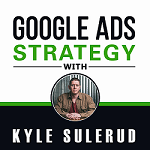Let’s talk about bidding strategies!
When setting up your YouTube campaign, you have several different options to choose from. But first, how do they work and how do they affect the results of your campaigns?
When creating a campaign, you select a goal. Depending on what the goal is, there will either be one or a couple of different bidding strategies to choose from. In fact, the only difference when choosing one goal compared to another is the bidding strategy.
There are two bidding strategies that utilize your conversion data. (A conversion is some action that you want a user to take on your website, whether it is an opt-in, a download, a purchase, etc.) In order to use one of these conversion-based bid strategies, you must have conversion tracking set up in your account.
The first option is Maximize Conversions. Maximize Conversions basically gives Google a daily budget to work with that they will use to get as many conversions as possible while meeting the budget.
The second option is Target CPA bidding, which means Target Cost Per Action (basically, Target Cost Per Conversion). With this strategy, you basically set a guideline for Google by saying, “I want you to get as many conversions for me at X amount as possible.” Target CPA won’t necessarily spend your entire budget, while Maximize Conversions usually does. The focus with Target CPA is on trying to get conversions for the amount that you are targeting.
In both of these options, while we are bidding for conversions, we are not paying Google for the conversion, but per view. So you may be bidding $10 per conversion, but Google might bring conversions to you for $50. Then you’re out of luck! If that’s the case though, the system is not going to go on very long while bringing you $50 conversions. Instead, traffic is going to slowly disappear because Google’s system will slowly learn that it can’t bring in conversions for $10 apiece and therefore it will mostly stop trying. (Your options if that happens are to increase the Target CPA bid, or change up your ads or do something else to try to get conversions at a lower cost.)
If you’re tracking conversions, you definitely want to use a conversion-based bidding strategy.
Out of these two strategies then, which one do I recommend? Well, I can tell you that all of the campaigns that I run, including campaigns that I’ve scaled to over six-figures a month in ad spend, are all using Target CPA.
The reason I use Target CPA is that it allows for a lot more control. You can bid differently per conversion for different types of targeting because, as we all know, not all conversions are created equal. So this gives you the ability to pay more for really highly targeted traffic or pay less for traffic that may not convert as well in the end, like if you’re bidding for leads but ultimately you are trying to produce high-ticket sales.
Even though I use and highly recommend Target CPA bidding, I’ll explain two more bidding strategies that can be used for YouTube Ads.
Maximum CPV (which means cost-per-view) means setting a maximum amount that you want to pay per view. Pretty self-explanatory, huh? In this case, Google is not going to go over what you’re bidding. So if you choose to bid a maximum of $0.05/view, all of the views that come in through the campaign are going to cost $0.05 or less. But with this strategy, Google’s goal is not to get you conversions – its goal is simply to get you views. A view counts when someone watches your ad for 30 seconds or longer, and often, the only reason that they are “watching” your ad is because they’re not paying attention at all.
This especially happens if you’re not excluding any channels or topics, resulting in your ads being shown on low-quality channels such as kid channels or music video channels. Google still gets to count that ad as a view. It also means that these channels do not often show ads from advertisers who are using conversion-based bidding because the system recognizes that these channels are not good.
So, with CPV bidding, you’re basically getting the scraps. You’re getting views in terms of what a view means, but you’re not necessarily getting actual people viewing the ad.
And the last bidding option is called Target CPM, which means target cost per one thousand impressions. (If you didn’t know, the M comes from the Latin word “mille”, which means 1,000.) So Target CPM is the target per one thousand impressions. This is the bid strategy connected to the “brand awareness and reach” goal.
Here, you are once again giving Google a new goal. This asks Google to provide as many impressions as possible. But an impression is different from a view because an impression can be someone who might have started watching the ad and then skipped it right away, or they could’ve watched the entire ad. Basically anyone who saw any of your ad counts as an impression.
The goal for Google is to get you cheap impressions. Your ad will be shown to anyone that counts as an impression. This is generally very low-quality traffic – the scraps of the scraps.
This happens because if these people were actually the type of people who opted in for things and purchased things, they would see ads from advertisers who are using conversion-based bidding strategies. Don’t count on getting high-quality traffic with Target CPM.
So those are the different types of YouTube Ads bidding strategies. I stand by Target CPA because it has worked the best for me across multiple campaigns and brings in high-quality traffic, but there is a place for each of these bidding strategies. You just need to know your goals!
